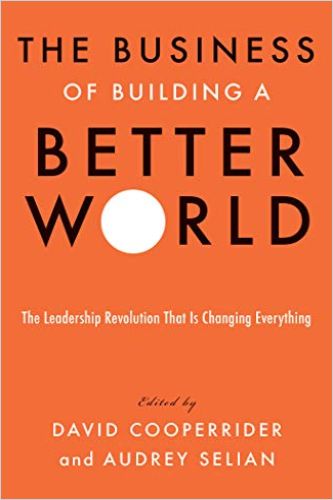“The ‘Great Trade-Off’ Is a Myth.”

David, your book The Business of Building a Better World is about how companies – not politics or NGO activists – can help prevent our societies and our environment from collapsing. Why did you feel you needed to make that point?
David Cooperrider: Well, one of my specializations is a large group or multi-stakeholder planning methodology called Appreciative Inquiry. That’s why I’m increasingly invited into all kinds of companies, industries and cities that want to build a framework for moving beyond sustainability to becoming net positive forces for good in the world. It all got a big boost with a surprising call. It was early in 2004 when one day, I got a call from Kofi Annan, the Secretary General of the United Nations. He invited me to form a team to design and facilitate what became the largest summit in the history of the UN between business CEOs from many industries and the United Nations. And in that meeting with hundreds and hundreds of C-suite executives, Kofi Annan started by reaching out his hand to the private sector and spoke about choice. “Let us choose,” he declared, “let us choose today to unite the strengths of markets with the power of universal ideals. And let us choose to reconcile the creative forces of private entrepreneurship with the needs of the disadvantaged, billions that live on less than $2 a day, and the requirements of future generations.” The leaders responded. Although I knew the science behind his words already, it became clear that:
Our most significant levers in the fight against the problems of the 21st century are not bans, laws and restrictions but a change, a global mind shift in corporate thinking.
Creating a sustainable planetary future and regenerative economy in the service of life cannot be done without the transformative power of the private sector, not alone, but in partnership with every component of the more than 90 trillion dollar economy. For me, the birth and growth of the UN Global Compact was a milestone. It marked the beginning of the era when the business of building a better world would increasingly become viewed as good business. And here is a fact not many people know. Our world summit at the UN ended symbolically in the General Assembly Hall of the UN. That in itself is not notable. What was striking was that, for the first time, the seats of the General Assembly Hall were not filled by heads of states but by heads of corporations. That moment spoke volumes.

And this is about innovation, not sacrifices?
Indeed. What’s behind it goes back to the futurist and pioneer in world modeling Willis Harman, who published a forecast for Stanford University titled Creative work: The constructive role of business in transforming society. He was looking at population and social trends, the destruction of the environment and growing inequality. He and his team came up with three scenarios for the future. The first scenario was a complete collapse of the ecological system and out-of-control feedback loops that we couldn’t deal with. The second was the nuclear holocaust – through accident, terrorist acts or armed conflicts. But then, the third and only optimistic scenario predicted that business could emerge as the most creative and positive force on the planet to build a better future.
What did he think it would take?
Harman said that all needed was a shift in global consciousness where leaders everywhere could see and operate from a stance of intimate interdependence, recognizing the integrity of all ecosystems, economies, and societal systems. I saw that emerging consciousness being played out at that meeting with Kofi Annan. I thought this was our moment where we could be galvanizing a collective project at a planetary level – a scale that we’ve never done before. This would be the era when doing good would be a force for imagination and innovation and industry leadership. So, I became committed to helping advance that movement. Today must be the decisive moment when we make the business of building a better world the impact story of our time. It involves mobilizing change at scales we have never seen.
Take-Aways:
- The biggest challenges in the near future are climate change, growing inequality, and social unrest.
- Competitive companies are faster and more efficient than states or NGOs to tackle these problems. They have the longest levers to pull to save the world from collapse.
- A green turnaround can be achieved by virtually any company. They just need to bring the positive and creative ideas of their employees to the table. There are thousands of examples of such change – and the vast majority have nothing to do with economic losses.
- Corporations with such a cause lead to people on purpose and vice-versa. So if your company contributes to the good by design, you no longer need to invent a crooked purpose.
In the book, you asked many experts for their opinions. So, let’s dive into the most significant global problems of the near future and the most promising business ideas to prevent them. What happened after the UN meeting?
After the meeting with the United Nations, Peter Drucker, the father of modern management theory, invited me to his home. He was well into his 90s, and I shared story after story of companies providing market-driven solutions to the world’s greatest social, ecological, and human challenges. And then he said:
David, I wrote about it many years ago! Every social and global issue is a business opportunity in disguise, waiting for the innovative, creative entrepreneur. Waiting for investment capacity. Waiting for the pragmatism of business to get things done.
Peter Drucker
And that’s what we see in companies worldwide: enterprises are emerging and turning huge problems into radical innovation opportunities and new blue ocean markets. For example, there are studies that say that 90% of the world’s carbon impact comes from some 70 companies. And Ørsted, formerly one of the most coal-intensive energy companies in Europe – like Exxon, but from Denmark – realized that it had to do something about it. It divested from fossil fuels. It completely re-invented itself.
What did they do?
Once they realized their impact, they did a turnaround and said, “Our vision is to create a world that runs entirely on green energy.” And they announced their reinvention model publicly, in front of stock exchanges and Wall Street and, with bold courage, their shareholders. It’s an audacious example and an unbelievable story of the kind of leadership we need. When you think about it, their pivot would be like going to one of the world’s biggest tobacco companies and having them declare in front of their shareholders that they’re going to become a nutritional excellence company. (Laughs.) No wonder everybody thought, “Oh, my gosh, what’s going to happen to their market value?” Today, we know that it tripled in market cap over the next three years.
That’s a massive transformation.
And it’s not due to new restrictions or laws. It’s all about consciousness and caring combined with conviction and creativity. The radical innovation side is always tied to good design thinking, based on “What is our intention?” For example, Toyota is building a net-positive city at the base of Mt. Fuji that gives back more clean energy to surrounding regions than it takes. It personalizes medicine and health for everybody. Take something more down to earth like Dutch footwear company OAT Shoes: They wanted to design a sneaker that young people will love but won’t need lots of advertising or marketing, made in renewable energy facilities with biodegradable materials. Along the way, they thought, instead of just doing less harm, how about a shoe that regenerates the planet, that replenishes our clean air? So, Michael, what did they do?
They created a shoe…?
Exactly. (Laughs.) And it’s called “Shoes that Bloom.” When your sneakers are worn down, you go out and plant them in your yard. And it turns into a tree. Companies like this ask heretical questions.
We have a data bank of 3,814 stories of radical innovation, all showing that being part of the ‘solution revolution’ is the pathway to great business – that the mantra ‘do good, do well’ is stated in that exact order for a reason.
It’s not “do well in order to do good.” Think of Unilever, Grameen Bank, Terra Cycle, Interface Carpets, Nothing New, Frontier Markets, Greystone Bakeries, Ikea, Ørsted, Tata, Patagonia… the list is exploding. This is innovation’s frontier.
The OAT story is a great example. But to come from good intentions to a valid business idea takes a lot of stamina. Can you say something about best practices on the way?
I think deep down, every one of us knows that we’re on a collision course, that the next two decades – the next decade and a half – are going to be decisive.
The most important thing companies can do is call the whole organization to create a new business framework that gives back more to the world than they take.
I already mentioned the Appreciative Inquiry method. It’s a “whole-system-in-the-room” way to bring the company to life on the inside, to spark massive transformation while energizing people and partners. Green Mountain Coffee Roasters, for example, was a small company in Vermont some years back. Bob Stiller, an entrepreneur, bought the company, and he called me. The firm was near bankruptcy. And he said: “I want to bring our whole system in the room, every level from parking lot attendant to CEO; and not just the internal stakeholders, but customers and the whole community in Vermont, even our coffee growing partners worldwide. I want to bring them all together, internal and external stakeholders, and design a new framework for going beyond sustainability to be a net-positive force for good in the world.” So, we facilitated that kind of design summit. It was called “Preparing for an Era of Phenomenal Growth and Phenomenal World Impact.”
So, what does such a session look like, and what happened afterward at Green Mountain?
It’s three or four days, usually, and it is intensive design, not just talking heads and pre-negotiated agreements. It’s rolling up your sleeves, designing everything from new net-positive products to ways to help build alliances and so on. And you start seeing people move towards electrification of everything and 100% renewable energy projects and creating the foundation to build on – in this case, the US Fair Trade Coffee Movement. You see people coming to life inside the company when they start looking at the outside, opening up product innovation and new markets. After these three or four days, these people began leading in their industry, reshaping the rules of the game in their sector – and, honestly, people were cheering for each other as they created this better world.
What exactly happened here? Dialogue, design thinking and exchange of ideas happen in many companies, so there must be a difference in your approach.
We call it Mirror Flourishing. It describes when we as human beings come together to create solutions to help the earth begin to flourish again and help regenerate. As we put our attention “out there,” guess who really comes alive? It’s all the employees involved. It’s the “in here” of the enterprise. Currently, we’re studying this mirror flourishing dynamic deeply. When we work for betterment beyond our organizations and give our energies to causes greater than ourselves, we flourish. It requires authentic co-creation in companies and managing business as a force for good is like a superpower. It brings people alive. It propels positive emotion and hope, inspiration, engagement and joy.
Green Mountain started doing this kind of sustainable design annually, with some 500 stakeholders in the room interactively over three full days, and they held net-positive summits every year for the next ten years. It soon was ranked No. 1 on the ‘100 Best Corporate Citizens’ list two years in a row, which had never happened to any company before. And it went from a small company with 157 million sales to a market value of 24 billion in a decade.
But the main reason for some of the excitement I see growing is not just the business value being created in these companies. It’s the shift from the language of sustainability to the language of flourishing.
Can you explain that in greater detail?
The word “sustainability” got us off on the wrong foot. The term has taken the shape of “Let’s make less harm, less of this, less of that, less climate impact, and so on.” Now, we’re moving towards the word “flourishing,” and in the book, we call it “Full Spectrum Flourishing.” Its North Star is to build a world where organizations and economies can excel, all people can thrive and nature can flourish, not just now but across the generations. We do not just want to sustain. Imagine if you’re exchanging wedding vows with your marriage partner and you said to each other, “Our goal is just to sustain our marriage.” (Laughs.) No, that’s not inspiring. Instead, it is: “We want a partnership that thrives in a relationship that flourishes.” So, the language of flourishing is essential in the company successes that we’re seeing, and I think it’s safe to say that the way from Appreciative Inquiry to Full Spectrum Flourishing is the most powerful to bring companies and their sustainability framework to life.
Related Articles In Our Journal:
There is a lot of talk about B-Corporations and Positive Impact Companies these days. Such firms set standards around environmental and social performance and, on average, outperform comparable traditional corporations. So what is the business secret of such alliances?
We see in our studies that once companies realize their new power, they suddenly see they can play even bigger than they are. There is an emergence of new mega-communities, not communities of individuals, but communities of corporations like the B Team in Europe, for example. It was started by Sir Richard Branson and Jochen Zeitz, former Chairman and CEO of PUMA. It includes great people like Halla Tomasdittor, CEO of the B Team, Arianna Huffington, founder of the Huffington Post, Paul Polman, former CEO of Unilever, Jesper Brodin, CEO of IKEA and Christiana Figueres, the leader of the Paris Agreement. In such mega-communities, the contributing companies are playing bigger than they are by mobilizing all their peers and neighboring sectors. The science behind it comes from Mariana Mazzucato, a European economist. She studied about a hundred different countries, dealing with the question, “When is that country’s economy the most dynamic and alive?”
Her answer?
It’s when there’s something like a moonshot moment. Something that is seemingly impossible and therefore triggers many different players to try it anyway. This moment brings together private investment, government investment, companies, and citizens. These mega-communities are crucial to systems change, speed and scale. Today’s earthshot is the largest world macro-project in history and one where failure is not an option. It involves a re-design of the material basis of our civilization and can be framed as a question:
How might we achieve this tremendous goal – halving global emissions by 2030, and then go on to win the goal of net-zero emissions no later than 2050 – while leaving no one behind, advancing prosperity and well-being for all, and reversing nature loss and becoming nature positive?
A perfect storm. In a good way.
Yes. We are moving into this earthshot moment for all of humanity, which is big news. I mean, we’ve solved global problems before as a human family. For example, I studied the global eradication of smallpox, the first time in history that we ever solved a global problem. Think of the rebuilding after World War Two. But those things pale in significance to the mission that’s emerging now: to cut emissions in half within the next eight years, create a whole economic system that is net-zero, inclusive and just, and ultimately, moves towards regeneration.
It all sounds so simple now – but not every company has the chance to implement change in this form, right?
There may be exceptions, but there are fewer than one would assume. A couple of years ago, I was working with a trucking company. I was a truck driver myself for a while to save up for my studies, and I had a chance to work with the dockworkers and the truckers. As I started sharing stories about companies making this transition, they went to the CEO and said: “We think we should become a sustainable company. We even think we should go beyond sustainability to do better in the world.” And the company did! You see, anybody can spark that revolution. It doesn’t matter what level you are. Any person can come and start bringing the evidence to the senior team and get it moving.
And the old notion that if a company does good in the world, it will not do well in economic terms is not necessarily true?
The “great trade-off” is a myth. It’s nothing but an illusion. When such transformative initiatives fail and get expensive, that is usually because organizations make the same mistakes repeatedly. They fail because they don’t tap into the entire heart and commitment of every person in the company. If you treat transformational change just as a technical thing – “We’re going to have a group of experts come in and help us design!” – then it doesn’t become a movement within the company. It has got to become a movement from the heart and the spirit to work.
A shared vision is not simply an idea or a specific goal, but also a force in people’s hearts.
Can you give an example here?
I remember when I interviewed a young employee who worked at the Tesla showroom in Amsterdam. This was at a time people were laughing at the idea of zero emissions and electrification. Many were predicting quick bankruptcy for Tesla. But the young employee was on fire. He was articulate. He was open. Then I asked him: “What exactly is your job here?” His answer was stunning. He said: “My job is to electrify the renewable energy age.” I said, “No, no, no, I’m asking what’s your job here – on the display center floor.” He said, “You are not hearing me… my job is to help electrify the renewable energy revolution.” I tried one more time: “But how do you describe your job to your mother?” He said, “Just like I am sharing it with you. I have one of the best jobs in the world. I’m here to help electrify the renewable energy age.” Yes, this is what I mean. A business mission like this must become a force in people’s hearts.
A corporation with a cause leads to people on purpose and vice-versa.
So, it looks like all the “purpose”-related and often cramped efforts in the corporate world to provide more meaning at work are redundant when you set goals like this.
They are! People everywhere are looking to make their lives count and count affirmatively. A powerful purpose is something that people are likely to say at the end of their lives: “My life had meaning because I was a member of this community. I was a co-creator in this company’s future – and with it: the planet’s future.”
About the Author
David L. Cooperrider is a Distinguished University Professor at Case Western Reserve University and holds two chaired professorships: Char and Chuck Fowler Professor of Business as an Agent of World Benefit and the Covia – David L. Cooperrider Professorship in Appreciative Inquiry, both at the Weatherhead School of Management. Together with Audrey Selian, he published The Business of Building A Better World, which is nominated for the 2022 getAbstract International Book Award in the Business Impact category. Selian runs Artha Impact, an environmental and socially responsible investing firm. Visit www.Aim2Flourish.com for additional information.










